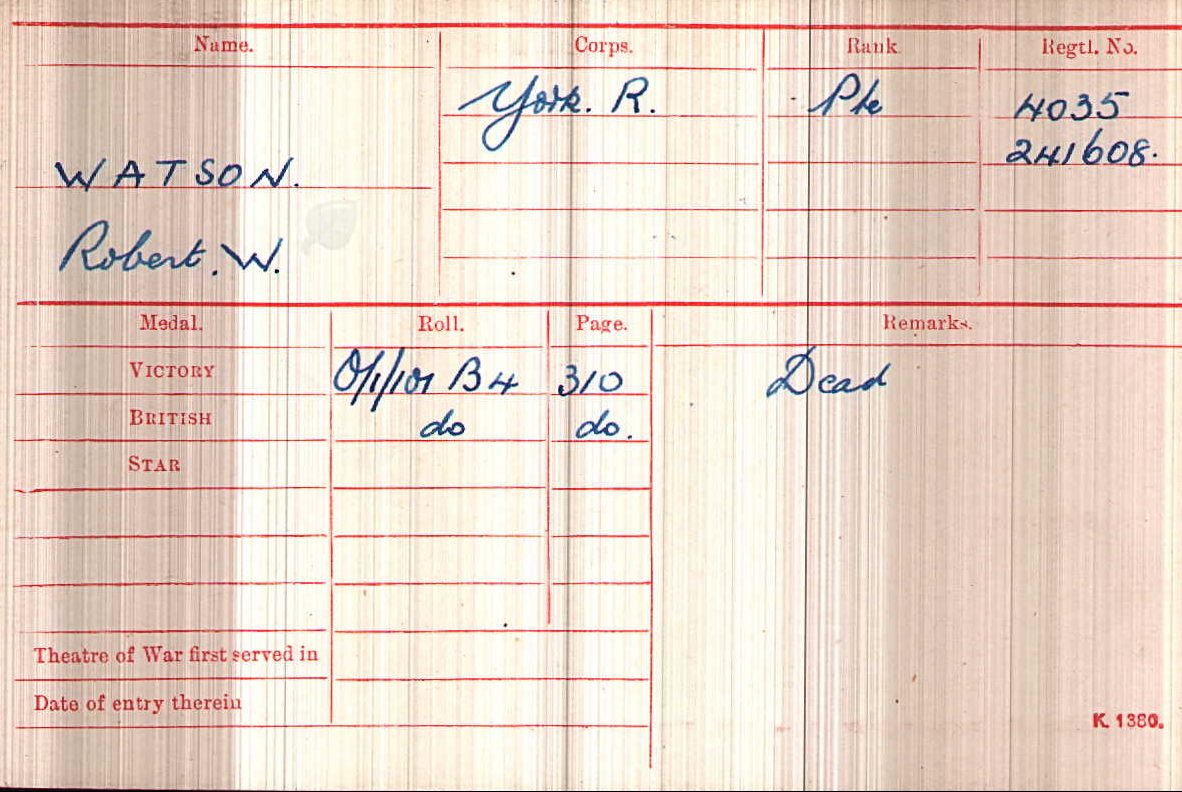
Submitted by Jon Bemrose.
Robert William Watson was the Fourth son of Alfred and Annie Watson, of 15, Ashville St., Bridlington. Before the outbreak of hostilities he was a fireman of the North Eastern Railway at Bridlington. 241608 Private Robert Watson served in the 5th Battalion Yorkshire Regiment and died on 28th October 1917 aged 21. His name is inscribed on the Tyne Cot Memorial in Belgium and on the cenotaph in Bridlington.
Explore more memories from the ribbon
-
John Sweeney
John Sweeny was 22 years of age when he enlisted in the Yorkshire Regiment in late 1914. He was the son of John and Mary Sweeney of Washington Station, Co. Durham. The 8th Battalion arrived in France in late August 1915 and John is reported to have been wounded in that November. He was again wounded in December 1916 and was killed in action in August 1917. The only reported 8th Battalion casualties at this period were working as Yukon Pack Carriers, re-supplying the front line with munitions in the area of Ypres. He is commemorated on Panel 33 of the Menin Gate at Ypres, Belgium. 144466 Private John Sweeney of ‘A’ Company was awarded the 15 Star, the British War Medal and the Victory Medal.
-
Harold Surtees
Jonathan Helm submitted this information about his Great Grandfather, Harold Surtees. Lance Corporal Surtees (2048/200407), was born in West Hartlepool and lived in Great Ayton. He volunteered for service in a local meeting on 2nd September 1914. Serving with the 1st/4th Battalion Yorkshire Regiment, he was posted to France as part of the 50th Northumbrian Division on 18th April 1915. Although little is known of his exact war record, his photograph indicates two wound stripes and the Whitby Gazette when reporting his death noted that he had been “three times wounded and gassed”. The only confirmed record of wounding is in the War Office Casualty List, which was printed in The Times on Wednesday 25th October 1916. This is likely to have occurred during the Battle of Flers-Courcelette (15th – 22nd September 1916) which was fought during the Battle of the Somme. He died on the 10th April 1918 (aged 26) from wounds sustained when the battalion fought at the Battle of Estaires in an attempt to stop the German advance. Harold is buried at the Haverskerque British Cemetery in France. He left behind his wife, Sarah, and their two children, Harold and Mary.
-
George Butterworth
At the outbreak of the First World War, George Butterworth was being described as the most promising British composer of his day. George was born in Paddington, London in 1885 but at the age of six moved to Yorkshire when his father became first solicitor and then General Manager of the North Eastern Railway Company. George inherited his mother’s talent for music (she was a professional singer before her marriage). His parents sent him to Aysgarth Preparatory School, near Bedale where he played the organ during school services. His musical ability led to him gaining an Organ Scholarship to Eton College. He initally entered Trinity College, Oxford with the intention of studying law, but this idea was abandoned as he became increasingly interested in setting down the folk music of the British Isles. At the outbreak of the First World War, George enlisted in the Duke of Cornwall’s Light Infantry and was later granted a commission in the Durham Light Infantry. He was on active service for almost a year and awarded the Military Cross in 1917. The citation states that he had commanded the Company when the Captain was wounded ‘with great ability and coolness … and total disregard of personal safety’. Less than a month later, on Saturday 5 August, he was shot through the head by a German sniper in ‘Munster Alley’. Only a day later, William Short of the 8th Battalion, Yorkshire Regiment undertook the action which led to his posthumous Victoria Cross in the same…
